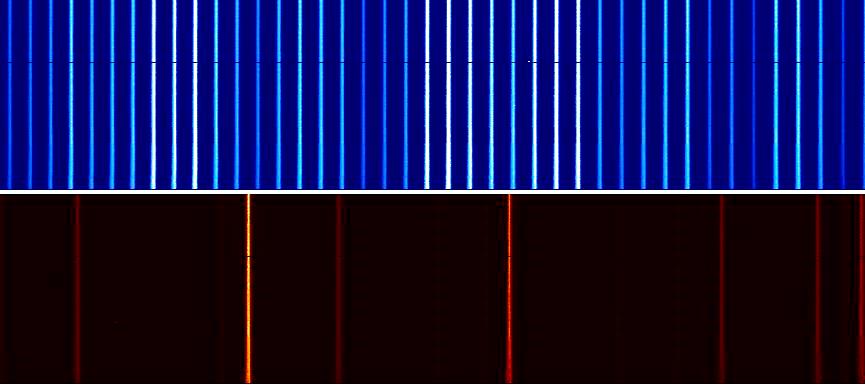A universal comb
Optical frequency comb allows more accurate astronomical observations
Optical frequency comb allows more accurate astronomical observations
Scientists from the Leibniz Institute for Astrophysics in Potsdam (AIP) and the Centre for innovation competence innoFSPEC have tested a novel optical frequency comb at an astronomical instrument. This new light source shall improve the calibration of spectrographs and hence their scientific measurements.
"The speciality of the light generated by the optical frequency comb is that it consists of individual, discrete colours, with exact frequency spacing in between," explains the responsible innoFSPEC scientist Jose Boggio. "The optical comb is created by the superposition of laser light with two different frequencies". The resulting spectrum is not continuous, as in a rainbow, but consists of different coloured lines with fixed intervals and dark gaps between them - hence the name frequency comb.

Selected spectrum of the optical frequency comb (upper, blue panel) as compared to a Neon spectral lamp emission (lower red panel). The comb is a better calibrator („optical ruler“), because it features more and equally spaced emission lines than the Neon lamp.
As to analyze the light from stars and galaxies, all spectrographs must be calibrated using a known light source. "The frequency comb serves as optical ruler, which is more stable and regular, than the light from conventional spectral lamps", explains astrophysicist Andreas Kelz. "Thanks to these methods, we will be able to determine the rotational speeds of galaxies or the chemical composition of stars more precisely."
The technique is known since 2005, the year in which two American and one German researchers received the Nobel prize for its development. "This technology was until recently very complex and expensive, and thus practically inaccessible, but innoFSPEC has managed to simplify and adapt it to the requirements of astronomical observation, which will be a milestone in spectroscopic studies," says Jesus Aceituno, deputy director of the Observatory Calar Alto (CAHA, MPG-CSIC).
After development in the laboratories of innoFSPEC in Potsdam, the frequency comb has undergone a first practical test on sky. For an observing campaign at the Calar Alto Observatory in southern Spain, the AIP-built PMAS spectrograph was equiped with the frequency comb. After the successful outcome of these tests, Roger Haynes, head of the innoFSPEC research group, is sure that optical frequency combs will set a new standard in astronomical precision spectroscopy and laboratory analysis.
The German-Spanish Calar Alto Observatory is located at Sierra de los Filabres, north of Almería (Andalucía, Spain). It is jointly operated by the Instituto Max Planck de Astronomía in Heidelberg, Germany, and the Instituto de Astrofísica de Andalucía (CSIC) in Granada, Spain. Calar Alto has three telescopes with apertures of 1.23m, 2.2m and 3.5m. A 1.5m aperture telescope, also located at the mountain, is operated under control of the Observatorio de Madrid.
Chavez Boggio et al., 2012. Generation of an astronomical optical frequency comb in three fibre-based nonlinear stages, SPIE, Vol. 8434, id. 84340Y.
Instituto de Astrofísica de Andalucía (IAA-CSIC)
Unidad de Divulgación y Comunicación
Silbia López de Lacalle - sll[arroba]iaa.es - 958230532
http://www.iaa.es
http://divulgacion.iaa.es

